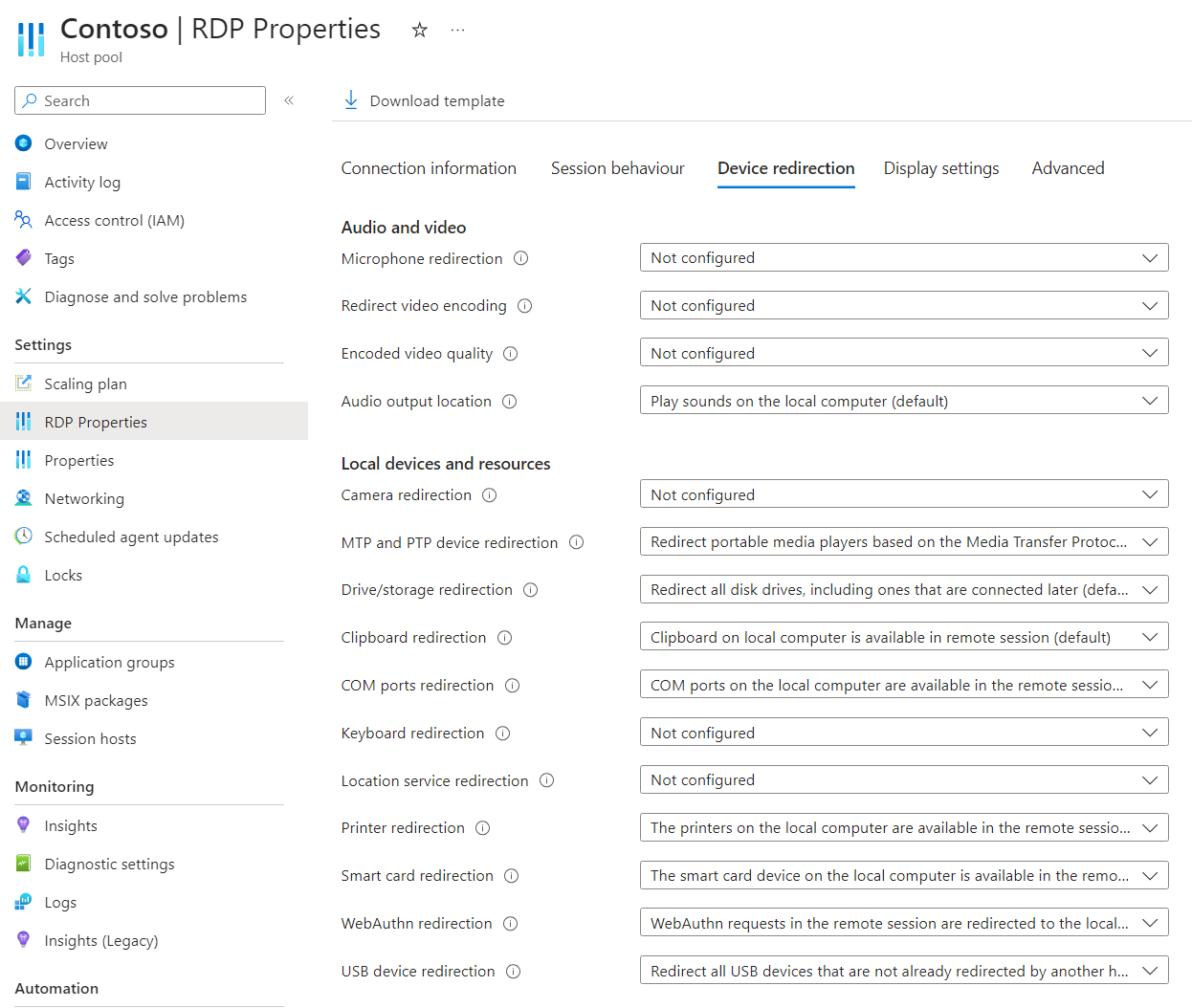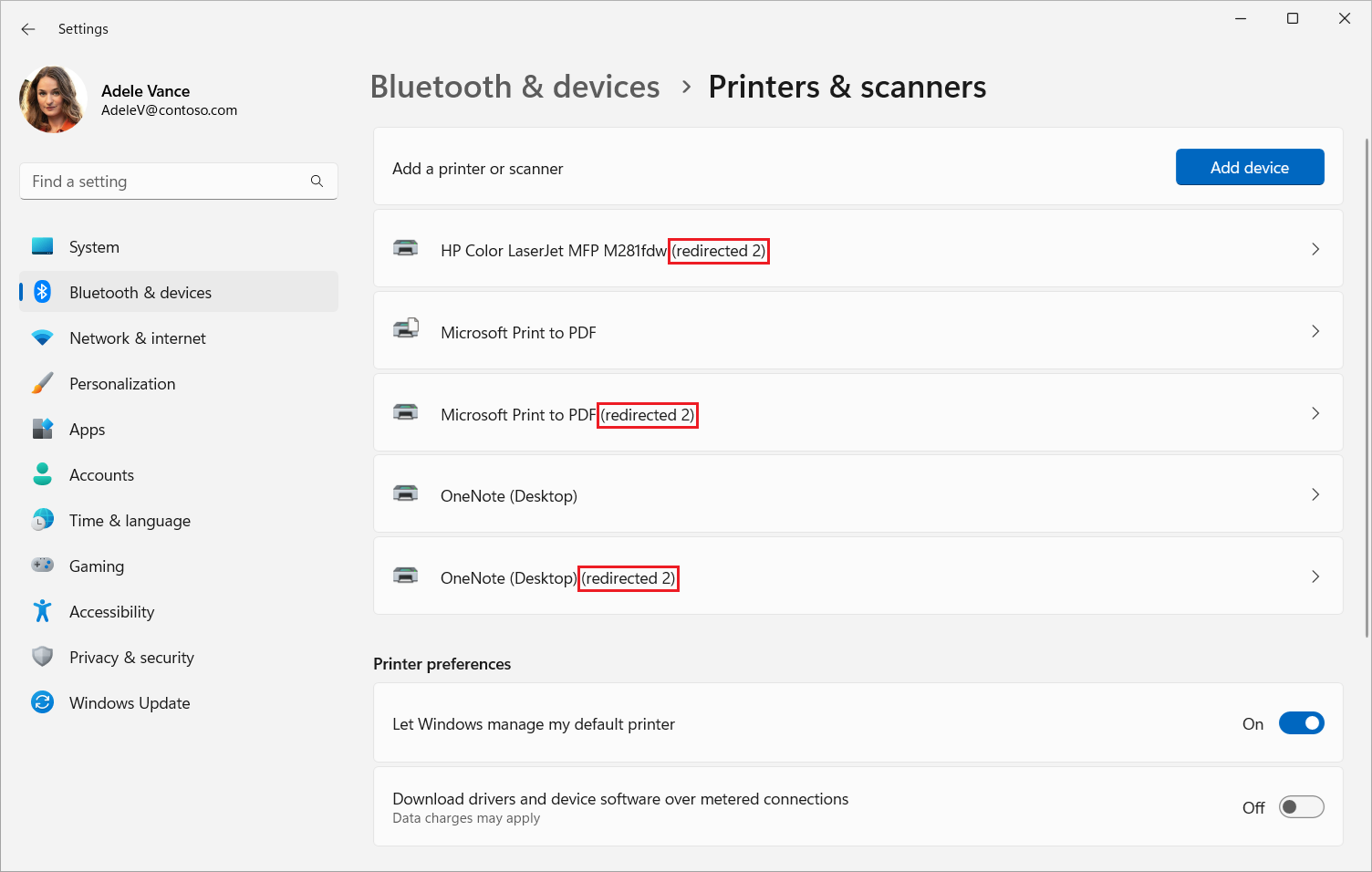Note
Access to this page requires authorization. You can try signing in or changing directories.
Access to this page requires authorization. You can try changing directories.
Tip
This article is shared for services and products that use the Remote Desktop Protocol (RDP) to provide remote access to Windows desktops and apps.
Select a product using the buttons at the top of this article to show the relevant content.
You can configure the redirection behavior of printers from a local device to a remote session over the Remote Desktop Protocol (RDP). Printer redirection supports locally attached and network printers. When you enable printer redirection, all printers available on the local device are redirected; you can't select specific printers to redirect. The default printer on the local device is automatically set as the default printer in the remote session.
Printer redirection uses high-level redirection and doesn't require drivers to be installed on session hosts. The Remote Desktop Easy Print driver is used automatically on session hosts. The driver for the printer must be installed on the local device for redirection to work correctly.
For Azure Virtual Desktop, we recommend you enable printer redirection on your session hosts using Group Policy, then control redirection using the host pool RDP properties.
Printer redirection uses high-level redirection and doesn't require drivers to be installed on a Cloud PC. The Remote Desktop Easy Print driver is used automatically on a Cloud PC. The driver for the printer must be installed on the local device for redirection to work correctly.
For Windows 365, you can configure your Cloud PCs using Group Policy.
Printer redirection uses high-level redirection and doesn't require drivers to be installed on a dev box. The Remote Desktop Easy Print driver is used automatically on a dev box. The driver for the printer must be installed on the local device for redirection to work correctly.
For Microsoft Dev Box, you can configure your dev boxes using Group Policy.
This article provides information about the supported redirection methods and how to configure the redirection behavior for printers. To learn more about how redirection works, see Redirection over the Remote Desktop Protocol.
Tip
Universal Print is an alternative solution to redirecting printers from a local device to a remote session. For more information, see Discover Universal Print and to learn about using it with Azure Virtual Desktop, see Printing on Azure Virtual Desktop using Universal Print.
Prerequisites
Before you can configure printer redirection, you need:
An existing host pool with session hosts.
A Microsoft Entra ID account that is assigned the Desktop Virtualization Host Pool Contributor built-in role-based access control (RBAC) roles on the host pool as a minimum.
- An existing Cloud PC.
- An existing dev box.
A printer available on the local device. You need to make sure local device has the printer driver is installed correctly. No driver is needed in the remote session as redirected printers use the Remote Desktop Easy Print driver.
To configure Group Policy, you need:
- A domain account that has permission to create or edit Group Policy objects.
- A security group or organizational unit (OU) containing the devices you want to configure.
You need to connect to a remote session from a supported app and platform. To view redirection support in Windows App and the Remote Desktop app, see Compare Windows App features across platforms and devices and Compare Remote Desktop app features across platforms and devices.
Printer redirection
Configuration of a session host using Group Policy, or setting an RDP property on a host pool governs the ability to redirect printers from a local device to a remote session, which is subject to a priority order.
The default configuration is:
- Windows operating system: Printer redirection isn't blocked.
- Azure Virtual Desktop host pool RDP properties: All printers are redirected from the local device to a remote session and the default printer on the local device is the default printer in the remote session.
- Resultant default behavior: All printers are redirected from the local device to a remote session and the default printer on the local device is the default printer in the remote session.
Important
Take care when configuring redirection settings as the most restrictive setting is the resultant behavior. For example, if you disable printer redirection on a session host with Group Policy, but enable it with the host pool RDP property, redirection is disabled.
Configuration of a Cloud PC governs the ability to redirect printers from a local device to a remote session, and is set using Group Policy.
The default configuration is:
- Windows operating system: Printer redirection isn't blocked.
- Windows 365: All printers are redirected from the local device to a remote session and the default printer on the local device is the default printer in the remote session.
- Resultant default behavior: All printers are redirected from the local device to a remote session and the default printer on the local device is the default printer in the remote session.
Configuration of a dev box governs the ability to redirect printers from a local device to a remote session, and is set using Group Policy.
The default configuration is:
- Windows operating system: Printer redirection isn't blocked.
- Microsoft Dev Box: All printers are redirected from the local device to a remote session and the default printer on the local device is the default printer in the remote session.
- Resultant default behavior: All printers are redirected from the local device to a remote session and the default printer on the local device is the default printer in the remote session.
Configure printer redirection using host pool RDP properties
The Azure Virtual Desktop host pool setting printer redirection controls whether to redirect printers from a local device to a remote session. The corresponding RDP property is redirectprinters:i:<value>. For more information, see Supported RDP properties.
To configure printer redirection using host pool RDP properties:
Sign in to the Azure portal.
In the search bar, type Azure Virtual Desktop and select the matching service entry.
Select Host pools, then select the host pool you want to configure.
Select RDP Properties, then select Device redirection.
For Printer redirection, select the drop-down list, then select one of the following options:
- The printers on the local computer are not available in remote session
- The printers on the local computer are available in remote session (default)
- Not configured
Select Save.
Configure printer redirection using Group Policy
Configure printer redirection using Group Policy
Select the relevant tab for your scenario.
To allow or disable printer redirection using Group Policy:
Open the Group Policy Management console on a device you use to manage the Active Directory domain.
Create or edit a policy that targets the computers providing a remote session you want to configure.
Navigate to Computer Configuration > Policies > Administrative Templates > Windows Components > Remote Desktop Services > Remote Desktop Session Host > Printer Redirection.
Double-click the policy setting Do not allow client printer redirection to open it.
To allow printer redirection, select Disabled or Not configured, then select OK.
To disable printer redirection, select Enabled, then select OK.
Ensure the policy is applied to the computers providing a remote session, then restart them for the settings to take effect.
Test printer redirection
Printer redirection uses high-level redirection; the printer is available locally and in the remote session concurrently, and requires the relevant driver installed locally. The driver for the printer doesn't need to be installed in the remote session as redirected printers use the Remote Desktop Easy Print driver.
To test printer redirection:
Make sure a printer is available on the local device that's functioning.
Connect to a remote session using Window App or the Remote Desktop app on a platform that supports printer redirection. For more information, see Compare Windows App features across platforms and devices and Compare Remote Desktop app features across platforms and devices.
Check the printers available in the remote session. Here are some ways to check:
Open Printers & scanners in the remote session from the start menu. Check the redirected printers appear in the list of printers. Redirected printers are identified where the name of the printer is appended with (redirected n), where n is the user's session ID. The session ID is appended to make sure redirected printers are unique to the user's session.
Open a PowerShell prompt in the remote session and run the following command:
Get-Printer | ? DriverName -eq "Remote Desktop Easy Print" | Sort-Object | FT -AutoSizeThe output is similar to the following example:
Name ComputerName Type DriverName PortName Shared Published DeviceType ---- ------------ ---- ---------- -------- ------ --------- ---------- HP Color LaserJet MFP M281fdw (redirected 2) Local Remote Desktop Easy Print TS001 False False Print Microsoft Print to PDF (redirected 2) Local Remote Desktop Easy Print TS002 False False Print OneNote (Desktop) (redirected 2) Local Remote Desktop Easy Print TS003 False False Print
Open an application and print a test page to verify the printer is functioning correctly.
Optional: Disable printer redirection on a local Windows device
You can disable printer redirection on a local Windows device to prevent printers from being redirected to a remote session. This method is useful if you want to enable printer redirection for most users, but disable it for specific Windows devices.
As an Administrator on a local Windows device, open the Registry Editor app from the start menu, or run
regedit.exefrom the command line.Configure the following registry key and value. You don't need to restart the local device for the settings to take effect.
- Key:
HKEY_LOCAL_MACHINE\Software\Microsoft\Terminal Server Client - Type:
REG_DWORD - Value name:
DisablePrinterRedirection - Value data:
1
- Key:


